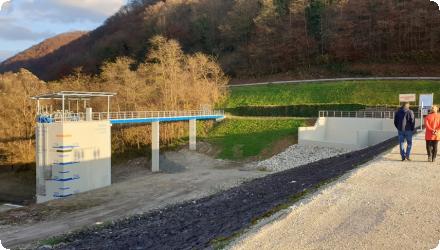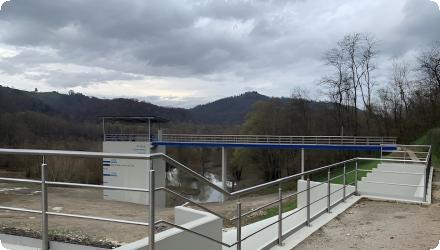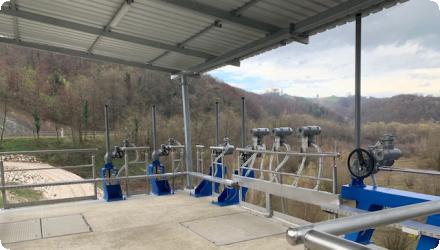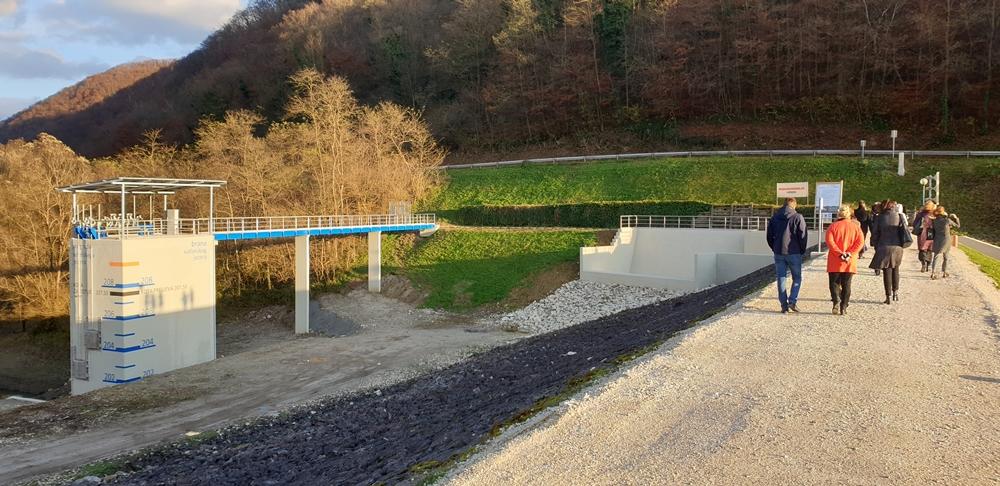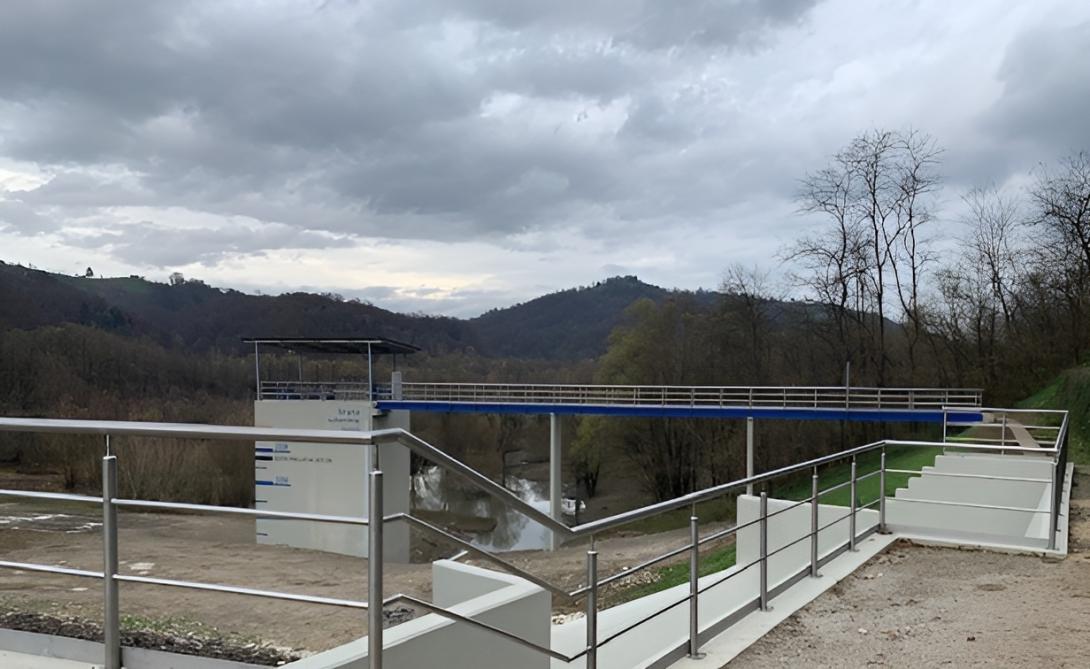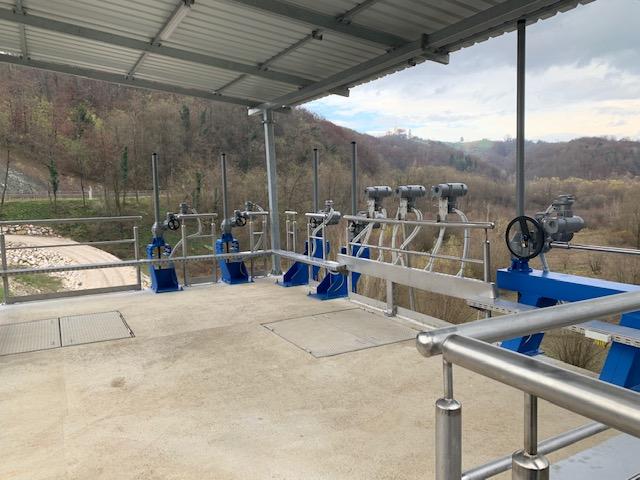Last update
2025
Summary
The Sutlansko Lake area is a wetland with a high biological diversity. The Vonarje reservoir was initially built in the early 1980s for drinking water supply, irrigation and flood protection along the transboundary Sutla/Sotla River between Croatia and Slovenia. The reservoir was later drained due to difficulties in managing its water quality and sedimentation. Since then, it has operated as a dry retention basin for flood protection. At the bottom of the reservoir, wetland ecosystems gradually developed. For this reason, the area of the reservoir on the Slovene side has been designated as a Natura 2000 site.
In recent years, the reservoir infrastructure was modernised through the FRISCO 2.1 project (2017–2019), funded by the Interreg V-A Slovenia–Croatia programme. The project aimed to reduce cross-border flood risks by reinforcing and upgrading the Vonarje dam and associated hydro-mechanical and electrical systems. The works were completed in 2019, enhancing the safety and functionality of the flood retention structure and improving its operational reliability.
The retention basin continues to serve as a key flood protection measure in the rural transboundary basin, offering temporary water storage during flood events while supporting ecological functions. Hydrological and sediment modelling have shown that the structure plays an important role in managing downstream sediment and nutrient flows, despite ongoing pressures from agricultural and point-source pollution.
In recent years, the reservoir infrastructure was modernised through the FRISCO 2.1 project (2017–2019), funded by the Interreg V-A Slovenia–Croatia programme. The project aimed to reduce cross-border flood risks by reinforcing and upgrading the Vonarje dam and associated hydro-mechanical and electrical systems. The works were completed in 2019, enhancing the safety and functionality of the flood retention structure and improving its operational reliability.
The retention basin continues to serve as a key flood protection measure in the rural transboundary basin, offering temporary water storage during flood events while supporting ecological functions. Hydrological and sediment modelling have shown that the structure plays an important role in managing downstream sediment and nutrient flows, despite ongoing pressures from agricultural and point-source pollution.
Position
Latitude
46.181
Longitude
15.628
Project
NWRM
National Id
Croatia_03
Installation date
1980
Implementation Status
Contact
Adriana Raveau, ACTeon
Transboundary
1
Photo gallery
Location of the project
The Vonarje reservoir is located near the village of Vonarje, directly on the Slovenia–Croatia border, adjacent to road 107 between Hum na Sutli (Croatia) and Podčetrtek (Slovenia).
NUTS Code
HR04 - Kontinentalna Hrvatska
Project's objectives
Flood prevention, downstream water quality improvements
Involved Partners
| Authority type | Authority name | Role | Comments |
|---|---|---|---|
Climate zone
cool temperate moist
Temperature
11
Precipitation
1200
Runoff
27
Runoff range
600 - 750 mm
Evapotranspiration
650
Elevation range
324
Water bodies: Ecological Status
Moderate
Water bodies: Chemical Status
Failing to achieve good
Water quality status
The reservoir suffered from extreme eutrophication shortly after its creation, leading to drainage in 1988.Even today, nutrient and sediment loads remain problematic due to diffuse and point pollution (agriculture, industry, wastewater).
Project scale
Meso
Project scale specification
Affects a significant part of a watershed, protecting several municipalities from flood risks.
Area subject to Land use change or Management/Practice change (ha)
590,6
Design capacity description
The Vonarje reservoir or Sutlansko Lake with a volume of 12.4 million m3 was built and filled in 1980 as drinking water supply and for flood as part of the joint water management plans of Croatia and Slovenia. Due to high risk to human and environmental health that has hardly been managed successfully, the reservoir was drained in 1988. Now it operates as a dry retention basin for flood protection.
Total cost
unkown
Financing authorities
Type of funding
National funds
Comments
The reservoir was built as part of the joint water management plans of Croatia and Slovenia.
Community involvment
No
Design consultation activity
| Activity stage | Name | Key issues | Comments |
|---|
Policy target
| Target purpose |
|---|
|
Peak-flow reduction
|
Policy pressure
| Pressure directive | Relevant pressure |
|---|
Policy impact
| Impact directive | Relevant impact |
|---|
Requirement directive
| Requirement directive | Specification |
|---|
Contractual arrangements
0
| Arrangement type | Responsibility | Role | Name | Comments |
|---|
Part of wider plan
0
Wider plan type
| Wider plan type | Wider plan focus | Name | Comments |
|---|
Water quality is monitored at four stations in Croatia
Parameters mentioned include overall water quality class trends, nutrients (N, P) and sediments.
Maintenance
Modernization and equipement upgrade once, during the FRISCO 2.1 project (2017-2019)
The structure reduces flood risk for several towns (e.g., Hum na Sutli, Podčetrtek, Rogaška Slatina), increasing local safety.
The area has potential for tourism and education, including proposals for:
Recreation and eco-tourism
Nature learning areas
Cultural and wellness tourism (e.g., nearby spas)
Recreation and eco-tourism
Nature learning areas
Cultural and wellness tourism (e.g., nearby spas)
Retained water
12400000
Retained water unit
m3/day
Information on retained water
Capacity is 12.4 million m3, of which 3.7 million m3 is required for 100-year flood protection.
Information on Reducing flood risks, quantity
The dry retention basin helps mitigate floods by temporarily storing water during high-flow eventsHydrological modelling (HEC-HMS and SWAT) confirms its importance for downstream flood protection.
Water quality overall improvements
Not relevant for this application
Information on Water quality overall improvements
Due to the implementation of the European industrial and urban waste water treatment legislation and environmental agricultural policy in Slovenia and Croatia (Croatia becoming a new EU member State in 2013), emissions to water and risk to water quality in the Vonarje reservoirs are expected to be much lower in the future than in the 1980's. Nevertheless, past pollution residuals in the lake bottom, pollution due to higher traffic, pressure on the water environment from fisheries, touristic and recrational facilities, intensification of agricultural activities and expected changes of climate patterns do not necessarily support this expectation. Furthermore, uses of the catchment on the Slovene an Croatian side are a different. On the Slovene side, there is more industry, "industrial like" tourism (large congress, termal and wellness facilities) and larger urban areas. On the Croatian side, the catchment uses are mostly traditional agriculture. The water uses are less intensive. Waste water collection and treatment depend on settlement patterns and differ in the technologies applied.
Soil quality overall soil improvements
Positive impact-SQ improvement
Information on Soil quality overall soil improvements
At the bottom of the reservoir wetland ecosystems developed. For this reason, the area of the reservoir on the Slovene side has been declared as Natura 2000 site.
1
The Vonarsko Lake area with its specific geographical features, as well as ecological and economic characteristics, has numerous water resources and an extremely rich flora and fauna. This area is considered as a wetland, the value of which is reflected in the biological diversity of the flora and fauna, ecosystems, and landscapes. This region is also extremely important for research and education. In short, there are many reasons for preservation and protection.
Information on Ecosystem impact climate regulation
No information found
Ecosystem provisioning services
1
Information on Ecosystem provisioning services
In the course of the past decade, the area of the Sutla (Sotla) catchment developed touristically. At present, there are many local and regional initiatives to fill the Vonarje reservoir with water again and develop touristic and recreational facilities along its shore. There are also initiatives to use water for irrigation and drinking water supply. Both Slovenia and Croatia, being the new EU Member State, are now faced with the great challenge to achieve not only the good ecological and chemical status of the Vonarje lake and the river Sutla (Sotla) (as directed by Water Framework Directive), but also to achieve good or excellent quality for bathing and protection from adverse effects of water. Furthermore, both have also to harmonise touristic, recreational, fishing and irrigation needs at the same time.
Key lessons
The Sutlansko Lake area is a wetland with a high biological diversity. The Vonarje reservoir was initially built for drinking water supply and flood protection. The reservoir was drained due to difficulties encountered to manage its water quality. Now it operates as a dry retention basin for flood protection. At the bottom of the reservoir, wetland ecosystems developed. For this reason the area of the reservoir on the Slovene side has been declared as a Natura 2000 site.
Success factor(s)
| Success factor type | Success factor role | Comments | Order |
|---|---|---|---|
|
Successful coordination between authorities
|
main factor
|
<p>Both EU countries, Slovenia and Croatia, are expected to apply for new development and cohesion funds to develop environmental and other infrastructure in the catchment. For the water management, it is important to take into account the two national institutional systems and the different economic developments in the past two decades: Although there are strong cultural ties between local communites on both river sides, the challenge for catchment water quality management to secure good ecological and chemical status of the Sotla river today is even greater than it has been in the past.</p>
|
1
|
Driver
| Driver type | Driver role | Comments | Order |
|---|---|---|---|
|
Other
|
main driver
|
The main purpose was drinking water supply for both, Slovene and Croatian, settlements and flood protection of downstream areas.
|
1
|
Transferability
The concept of converting a degraded reservoir into a dry flood retention basin with ecological co-benefits could be adapted in other rural transboundary basins facing water quality degradation, sediment/nutrient pressures and/or flood risks.
English
